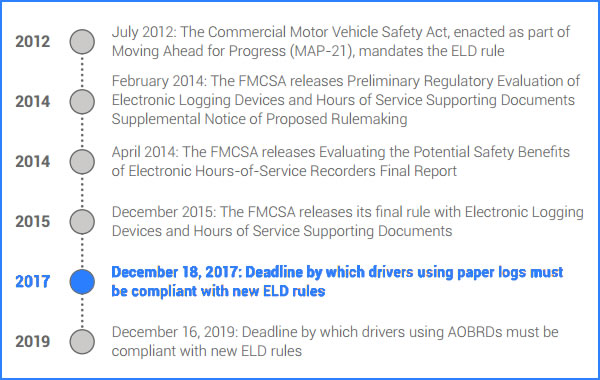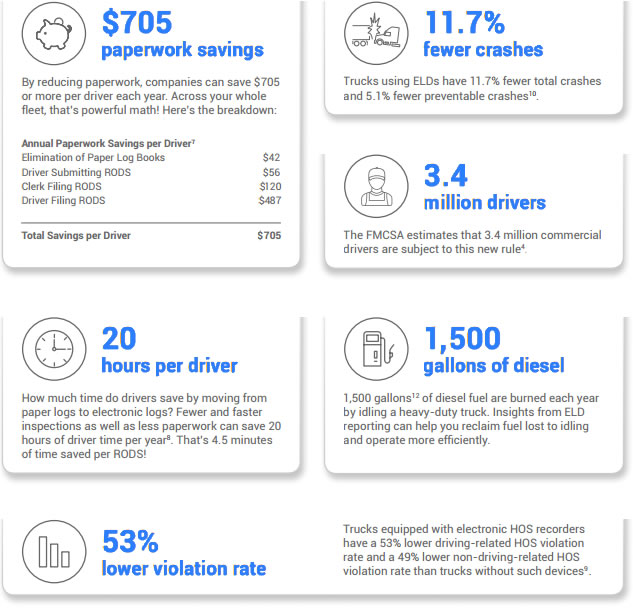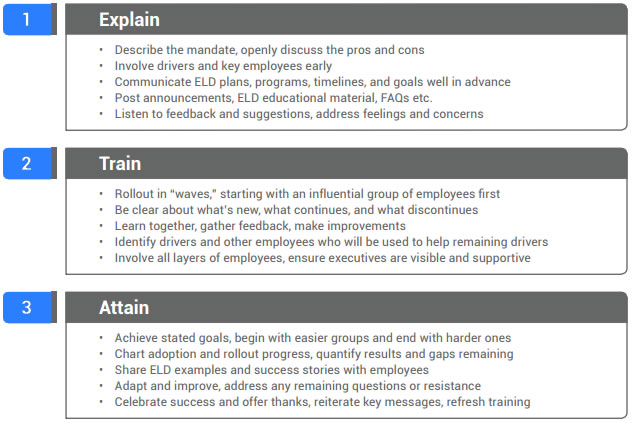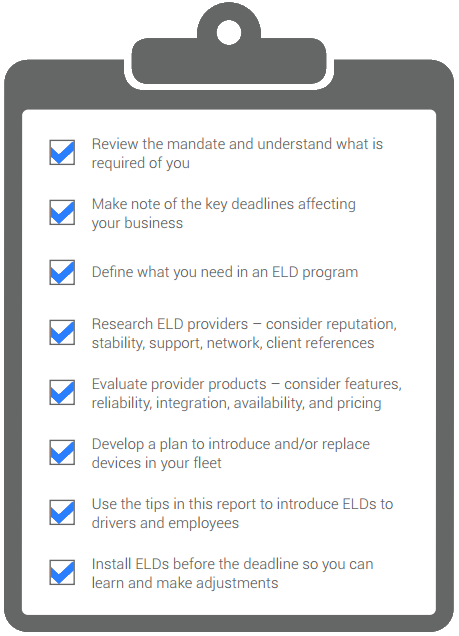ELD
The topic on everybody’s mind this year continues to be
electronic logging devices (ELDs). On December 10, 2015,
the Federal Motor Carrier Safety Administration (FMCSA)
issued a mandate requiring commercial trucking companies
to use an ELD to record their hours of service (HOS).
The FMCSA stated that the new rule “improves commercial motor vehicle (CMV) safety and reduces the overall paperwork burden for both motor carriers and drivers compliance with the applicable HOS rules.
ELD Foundations
Moving from paper logs to electronic logs might seem like a big deal, but it’s really not. Electronic logs actually look similar to their paper counterparts but come with many automated features that make logging simpler. Logs appear on the screen of a smartphone or other wireless device and can generally be viewed, printed, or emailed to an inspection officer upon request.

What is an ELD
The electronic logging device is a small device that can be held in the palm of your hand and plugged in to your vehicle. Once installed, the FMCSA notes that “an ELD synchronizes with a vehicle engine to automatically record driving time, for easier, more accurate hours of service (HOS) recording2.” The introduction of ELDs was designed to reduce the burden of manual, paper-based work and replace it with automation that improves compliance.
The ELD involves new technology, new processes, and new benefits. Today, those who need to comply are using a combination of paper logs, automatic on-board recording devices (AOBRDs), ELDs, and other logging software. In the near future, all will be using ELDs.
How does an ELD work?
Instead of using paper logs, drivers can plug in an ELD then manage logs by using integrated software on a mobile app. The app will even perform some of the functions automatically by receiving truck data from the ELD. In addition to automating and simplifying paper-based logging, an ELD often has additional features that help fleets.
ELDs can monitor engine health and activity, alerting drivers and fleet managers to maintenance issues and usage patterns. ELD software provides information about engine status (on/off), engine hours, idling, vehicle movement, vehicle location, mileage, miles driven, and more. To provide many of these insights and to complement logging features, an ELD may include GPS, accelerometer, and cellular and/or Bluetooth® capabilities.
FMCSA Requirements
As with many regulations, the ELD mandate has taken years to research the logging technology, analyze the regulatory impact, gather public feedback, publish the final rule, and prepare the industry. Some have since wondered whether the ELD mandate will move forward, be amended, or be withdrawn. There has been no indication, however, that the mandate will be withdrawn or amended, and many trucking companies have already moved forward and purchased an ELD so they can be compliant.
In addition to compliance, many carriers have made the move to ELD because the price of an alternative AOBRD is more expensive – often ranging between $500 and $2,000 whereas an ELD’s price generally ranges between $100 and $200. Carriers are also realizing benefits by the simultaneous convergence of fleet drivers moving from AOBRDs to ELDs and owner-operators moving from paper to ELDs. For the first time, the fleet can now have all drivers using the same type of technology.
Mandate Summary
The electronic logging device rule “requires ELD use by commercial drivers who are required to prepare hours-of-service (HOS) records of duty status (RODS).”3 In general, if you are already required to maintain RODS, you will still need to do so under the mandate. You’ll just meet the requirement by using an ELD. The FMCSA estimates that 3.4 million commercial drivers are subject to this new rule.
Commercial drivers who use paper RODS for 8 or more days, out of every 30-day period, will need to use an ELD. Motor carriers who use paper logs today will need to use electronic logs under the new mandate. And those currently using AOBRDs will also be required to use ELDs. The FMCSA notes certain exceptions to the mandate.
Mandate Exceptions5:
- Using paper duty status records for not more than 8 days out of every 30 days.
- Operating a vehicle that was manufactured prior to the year 2000.
- Driving a vehicle that is also the product to be delivered (drive-away/tow-away).
- Using time cards while conducting short-haul operations covered by an exemption.
Mandate Timeline
If you are required to comply with the new ELD mandate, you must install
and use ELDs by the following deadlines:

The timeline below summarizes the important dates and regulatory actions of the ELD Mandate

Multi-phased Approach
The FMCSA has organized the ruling into three phases of implementation and compliance.
They are summarized in the table and descriptions below.
Approved Log Methods by Phase6

Phase 1: Awareness and Transition
During the awareness and transition phase, carriers and drivers subject to the rule should understand what they need to do and prepare to comply with the ELD mandate. They may install and begin using ELDs.
Phase 2: Phased-in Compliance
During the phased-in compliance phase, carriers and drivers subject to the rule may no longer use logging software or paper as a means of compliance. They will now use approved ELDs to comply. AOBRDs installed prior to Phase 2 may also be used to comply.
Phase 3: Full Compliance
During the full compliance phase, all carriers and drivers who are subject to the federal mandate must be in compliance by using an ELD that meets the requirements of the rule.
Facts and Figures
The ELD mandate aims to save time and money as well as improve safety and compliance.
Listed below are some interesting stats behind the mandate.

Benefits of Using ELDs
The following categories can be can be used to help fleets and drivers
better understand how the ELD mandate is beneficial.
Using an ELD saves time, and that time savings equates to greater earning potential. Fewer and faster inspections as well as less paperwork equal up to 20 hours of time saved each year8 . Those are hours that can be converted into driving time to earn additional client revenue.
Most of the paper log burden falls on drivers. Buying log books, having drivers file and submit records, and performing clerical tasks all have costs. By using an ELD, you can save on many of these costs. In fact, the FMCSA estimated the total annual paperwork savings to be $705 per driver7 !
Electronic logging automation improves accuracy of driver logs. Fewer violations mean fewer fines. You’ll avoid some of the expenses associated with critical maintenance issues, vehicle downtime, unauthorized vehicle usage, and out-of-route miles.
By using an ELD, drivers and fleets can better plan the day. With the ELD’s hours of service, alerts, and GPS features, you’ll know when and where to take breaks and stop for the day. Also, insights from speeding and engine idling reports can lead to changes that improve fuel efficiency
Trucks with ELDs have 11.7% fewer total crashes and 5.1% fewer preventable crashes10. You’ll benefit from accelerometer and accident reconstruction features that validate safe driving, a key factor in determining insurance rates. With real-time ELD mapping, roadside assistance is faster.
E-Logs increase compliance and reduce violations, both of which improve CSA scores. They also document safety and compliance success, which could lead to better jobs and higher pay for drivers. Companies may also be more willing to do business with you when they know you’re ELD compliant.
ELDs reduce tedious activities like DVIRs and IFTA reporting, including phone calls just to check in. They may also reduce IFTA audit risks. ELDs lead to more meaningful coaching, decreased driving while fatigued, and accurate pay information–enhancing quality of life and reducing driver turnover.
How to Introduce to Drivers
Most people aren’t thrilled about the idea of new regulations changing the way they do business. For the most part, commercial drivers feel the same way. Many view the mandate as infringing on personal privacy. That being said, many also recognize that using an ELD may make the job easier. Routine tasks are automated, and work is completed quickly and accurately. The likelihood of audit may go down. And paperwork completion is less tedious. All of these factors positively affect drivers.
Many drivers also recognize that their fleets achieve benefits from ELD usage. Asset utilization, safety, navigation, fuel efficiency, record-keeping, and compliance may all be improved. That creates a more efficient fleet, and a more efficient fleet is a more profitable fleet. That’s a shared benefit with drivers.

Checklist for Success
If you need to comply with the ELD mandate, now is the time to take action. Here are a few steps to help you get started.

The FMCSA also provides an ELD checklist for both drivers and carriers on its website:
Carriers: https://www.fmcsa.dot.gov/hours-service/elds/eld-checklist-carriers
Drivers: https://www.fmcsa.dot.gov/hours-service/elds/eld-checklist-drivers

